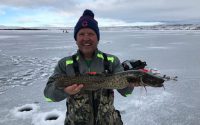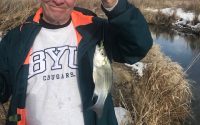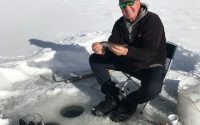Big Sand Wash — Catching Cold Water Bass
Bass wake up each year as water temperatures reach the magical 50 degrees. However, largemouth bass can be active in cold, cold water and even under ice, while smallmouth bass seem to disappear cold weather. However, there is such a thing as “cold water bass.” I once caught some giant smallmouth bass on Jordanelle Reservoir in north central Utah in 43-degree water … but I fished 40 to 50 feet deep with a jig, and moved the lure as slow as cold tar moving up hill.
We recently took a quick trip to Big Sand Wash Reservoir and were welcomed by 48-degree water and ZERO active largemouth bass. It was the first time I had seen or fished the reservoir so I didn’t know what to expect. My thoughts varied from wondering if there were just a few largemouth bass in the reservoir, or for some reason none of them had awakened as of yet.
Mike Tuvell, a good friend and fishing partner from time to time, decided on a plan to “sample” the water and searching for bites regardless of how we got them or the lures we threw. Michael enjoys fishing grubs on light line and weights (6-pound-test mono and 1/16 ounce darter head) and found the most consistent bites of the day. He started off with a 21-inch rainbow and then, after I caught my first smallmouth bass on a perch jerkbait (Pointer 78 Minnow), he proceeded to catch an additional three smallies on the same rock pile from which I caught my initial bass.
As the morning progressed we tried the backs, the middles, and the points all around the reservoir. We began catching fish either on the main points or about half way back from the main points in several skinny, long cuts. I threw spinnerbaits and jerkbaits (both large and small) and only came up to one bass while Michael caught the first six out of seven bass using soft plastics (176 grubs, green pumpkin black flack, and a California Craw Ned Rig).
I finally gave into the obvious realization that the bass were lethargic and simple were not chasing reaction lures. I switched first to a Senko (which didn’t produce) and then a small tube (2.5 incher) on a 1/8 ounce tungsten weight, and caught my first 2-pound smallie on the tube. I really like the Dry Creek Green Pumpkin with a Pumpkin tail (skirt chaser) and it didn’t let me down. I have no doubt I could have continued catching smallies with the tube but decided to switch to the Ned Rig (California Craw) because Mike Tuvell was doing so well with his Ned tied on.
From then on, we boated another 15 fish to end the day with around 22 to 25 bass caught between 8 am and 3 pm. The reason we didn’t keep a completely accurate count was the addition of trout to the equation. We discovered pods of spawning trout that literally chased down our lures in two separate areas. But, that story is another that will appear here tomorrow.
The key to cold water “bassin” is DOWNSIZING lures and slowing down the presentation. That is one thing I love about fishing with Michael Tuvell, he fishes very slowly and methodically, uses light line and small lures, and doesn’t try to compete with me from the back of my boat. He fishes “HIS” way and allows me to fish mine. On that day, he out fished me and when I recognized the simple fact that the fish weren’t chasing, I slowed down, changed lures, and fished very well for that last three hours of the day.
The lesson here is absolute: Down size and slow down if you plan on having a “cool” time when the water is cold.










